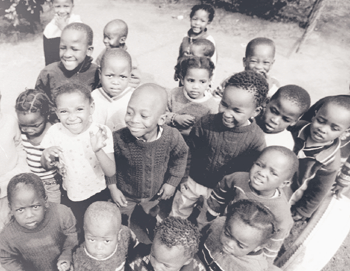Ramping Up the Fight
 |
|
AIDS activists loudly urged world leaders to ramp up the fight against this global scourge at the International
AIDS Conference in Barcelona this past July. James Curran, dean of the Rollins School of Public Health, began his
senior lecture at the conference with an acknowledgement of activism’s crucial role in accelerating drug
development and distribution and bringing attention to access to care worldwide.
“Silence does equal death!” he declared in his lecture titled: Reflections on AIDS: 1981 to 2031.
|
More than 20 scientists and clinicians from the Emory Center for AIDS Research (CFAR) brought a zealous
passion for the cause of AIDS eradication to Barcelona, along with decades of experience, innovative
interventions, and ground-breaking research studies. But much work remains to be done.
“After 21 years of the HIV revolution, the virus is clearly winning the battle,” Curran told delegates at the
conference. “This truth and my fear for the future makes me angry about the lack of progress worldwide on
prevention and about the denial, stigma, and abject poverty behind it.”
AIDS statistics remain staggering, both in lives lost and projections of future deaths. The virus has killed
22 million people—a half-million of those American—since the first handful of cases were identified more than
20 years ago. It is now the fourth leading cause of death in the world. An estimated 40 million people
worldwide are living with HIV, and there are on average 8,000 new infections a day. More than 800,000 babies
worldwide were born with the AIDS virus last year.
Indeed, news coming out of the 14th biannual conference was discouraging on many fronts. The 15,000 attending
scientists, clinicians, health care workers, people living with AIDS, politicians, and journalists were told
the following:
• AIDS will claim an additional 65 million lives by 2020—more than triple the number who died in the first
twenty years of the epidemic—unless prevention programs are rapidly expanded. “The epidemic is still in its
early stages,” stated a United Nations report.
• AIDS will leave 20 million children in Africa without one or both parents by 2010. “Even if by some miracle
the spread of HIV stopped today, the number of orphans would still rise for a decade,” said RSPH alumna E.
Anne Peterson, MD, 94MPH, of the US Agency for International Development.
• Of the 40 million HIV-infected people worldwide, just 700,000, or 1.75%, are receiving anti-viral drug
treatment.
• The epidemic is growing rapidly in Russia and Eastern Europe, the Caribbean, and China.
• Half of all new HIV infections are among 15- to 24-year-olds; and many young adults who have HIV are unaware
of their status.
• Rates of new HIV infections are vastly disproportionate among the world’s poor and minorities.
On a more promising note:
• Prevention programs in Zambia, Uganda, Poland, and Cambodia have been widely successful, leading to
declining HIV infection rates.
• The first nationwide program in a developing country to prevent HIV-transmission from mother to newborn has
proved highly successful in Thailand.
• An experimental drug called T20, or Enfuvirtide, has shown promising results in thousands of patients
infected with drug-resistant AIDS.
• Low-tech, low-cost tools like condoms are still some of the best weapons against the virus.
• The search for an AIDS vaccine is progressing, with several DNA-based vaccines advancing to clinical human
trials, including those developed at Emory.
Related article: Powerful Medicine
Winter 2002-2003 Issue |
Dean's Message |
In Brief |
Powerful Medicine |
CFAR
Going Places |
Fighting Global Violence |
Commencement |
Alumni Weekend |
Class Notes
2001-2002 Donor Report |
Rollins School of Public Health
Copyright © Emory University, 2003. All Rights
Reserved.
Send comments to
hsnews@emory.edu.
|
